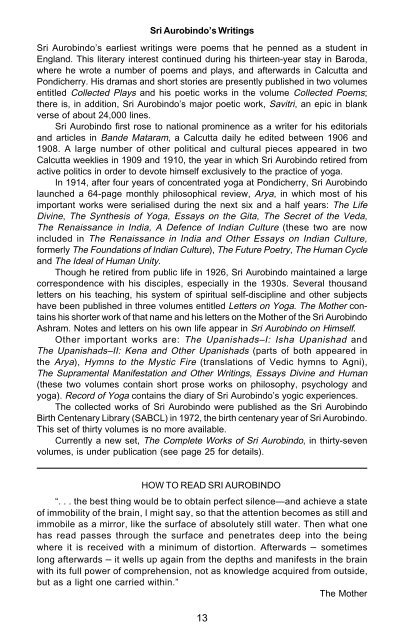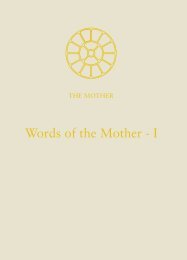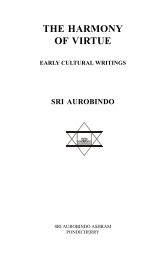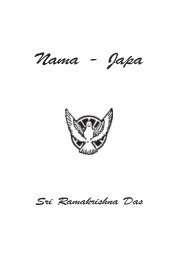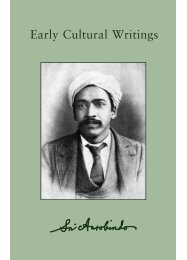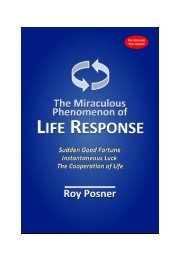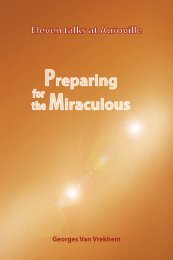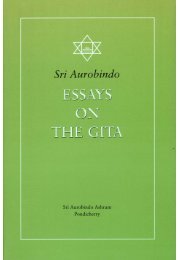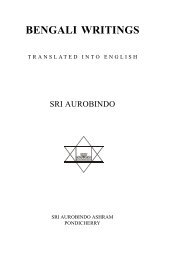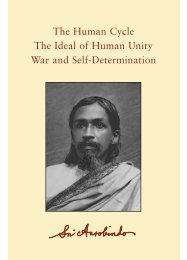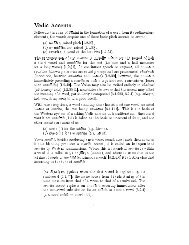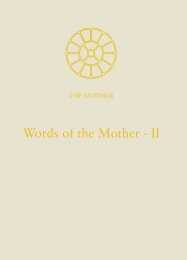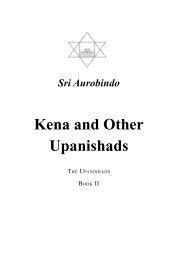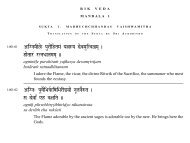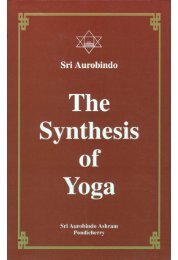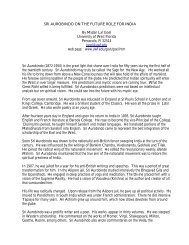Create successful ePaper yourself
Turn your PDF publications into a flip-book with our unique Google optimized e-Paper software.
Sri Aurobindo’s Writings<br />
Sri Aurobindo’s earliest writings were poems that he penned as a student in<br />
England. This literary interest continued during his thirteen-year stay in Baroda,<br />
where he wrote a number of poems and plays, and afterwards in Calcutta and<br />
Pondicherry. His dramas and short stories are presently published in two volumes<br />
entitled Collected Plays and his poetic works in the volume Collected Poems;<br />
there is, in addition, Sri Aurobindo’s major poetic work, Savitri, an epic in blank<br />
verse of about 24,000 lines.<br />
Sri Aurobindo first rose to national prominence as a writer for his editorials<br />
and articles in Bande Mataram, a Calcutta daily he edited between 1906 and<br />
1908. A large number of other political and cultural pieces appeared in two<br />
Calcutta weeklies in 1909 and 1910, the year in which Sri Aurobindo retired from<br />
active politics in order to devote himself exclusively to the practice of yoga.<br />
In 1914, after four years of concentrated yoga at Pondicherry, Sri Aurobindo<br />
launched a 64-page monthly philosophical review, Arya, in which most of his<br />
important works were serialised during the next six and a half years: The Life<br />
Divine, The Synthesis of Yoga, Essays on the Gita, The Secret of the Veda,<br />
The Renaissance in India, A Defence of Indian Culture (these two are now<br />
included in The Renaissance in India and Other Essays on Indian Culture,<br />
formerly The Foundations of Indian Culture), The Future Poetry, The Human Cycle<br />
and The Ideal of Human Unity.<br />
Though he retired from public life in 1926, Sri Aurobindo maintained a large<br />
correspondence with his disciples, especially in the 1930s. Several thousand<br />
letters on his teaching, his system of spiritual self-discipline and other subjects<br />
have been published in three volumes entitled Letters on Yoga. The Mother contains<br />
his shorter work of that name and his letters on the Mother of the Sri Aurobindo<br />
Ashram. Notes and letters on his own life appear in Sri Aurobindo on Himself.<br />
Other important works are: The Upanishads–I: Isha Upanishad and<br />
The Upanishads–II: Kena and Other Upanishads (parts of both appeared in<br />
the Arya), Hymns to the Mystic Fire (translations of Vedic hymns to Agni),<br />
The Supramental Manifestation and Other Writings, Essays Divine and Human<br />
(these two volumes contain short prose works on philosophy, psychology and<br />
yoga). Record of Yoga contains the diary of Sri Aurobindo’s yogic experiences.<br />
The collected works of Sri Aurobindo were published as the Sri Aurobindo<br />
Birth Centenary Library (SABCL) in 1972, the birth centenary year of Sri Aurobindo.<br />
This set of thirty volumes is no more available.<br />
Currently a new set, The Complete Works of Sri Aurobindo, in thirty-seven<br />
volumes, is under publication (see page 25 for details).<br />
HOW TO READ SRI AUROBINDO<br />
“. . . the best thing would be to obtain perfect silence—and achieve a state<br />
of immobility of the brain, I might say, so that the attention becomes as still and<br />
immobile as a mirror, like the surface of absolutely still water. Then what one<br />
has read passes through the surface and penetrates deep into the being<br />
where it is received with a minimum of distortion. Afterwards – sometimes<br />
long afterwards – it wells up again from the depths and manifests in the brain<br />
with its full power of comprehension, not as knowledge acquired from outside,<br />
but as a light one carried within.”<br />
The Mother<br />
13


